Molting is general among crustaceans. The hard shell of the crab prevents growth and so at intervals of about one year the entire hard shell of the crab is cast off or molted. Before the actual molt, a new protective covering is started, but this is uncalcified and therefore soft. During the period when the shell is cast off, the crab is known as a "soft" crab and it is during this interval of a few days that the crab undergoes a period of rapid growth before the new shell becomes calcified and fixes the size of the crab until the next molt. At molting time the old shell slits at the junction of the carapace and the abdomen, or tail flap, and the crab, now in the soft shell stage, backs out of the old shell through this slit. It is during the molting period that missing legs are rejuvenated. Following the first molt, after such a mishap, a replaced leg is considerably smaller than the original, but with succeeding molts it attains its normal size.
The abdomen, or tail flap, which is folded closely against the underside of the crab, is much broader in the female than in the male crab. This broad tail flap is necessary in the female to accommodate at spawning time the huge numbers of eggs that are attached and receive protection between this flap and the body until hatched. In the adult stage, the comb-like fringe of hair around the edges of the tail flap is quite long in the female but rather short and hardly noticeable in the male (for examples, compare Figures 2A and 2B or Figures 4 and 5) . The average size of female Cancer-type crabs is significantly less than that of the male crabs in the adult stage. The female Dungeness crab seldom attains a width much greater than 7 inches measured just anterior of the tenth anterolateral spine.
The legal measurement for crabs is defined as the shortest distance through the body from the edge of the shell to the edge of the shell directly from front of points (lateral spines).
The photographs and descriptions given on the following pages should enable the reader to identify the five common species of cancroid crabs.
Anyone who is interested in a more detailed description of these crabs, as well as descriptions of other crabs found in California, is referred to the publications listed in the reference section.
Metacarcinus magister
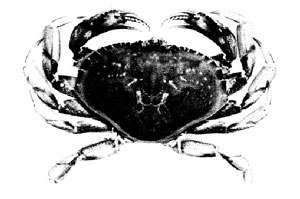 FIGURE 1. Dungeness crab, Metacarcinus magister. Top view of a 7-inch male.
FIGURE 1. Dungeness crab, Metacarcinus magister. Top view of a 7-inch male.
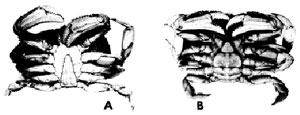 FIGURE 2. Dungeness crab, Metacarcinus magister. Underside view of (A) a male crab, 7 inches across the back, (B) a female crab, 6 inches across the back.
FIGURE 2. Dungeness crab, Metacarcinus magister. Underside view of (A) a male crab, 7 inches across the back, (B) a female crab, 6 inches across the back.
Distinguishing Characters: White-tipped pincers on the claws (chelipeds). The top edges of the claws and upper pincers are prominently sawtoothed, there being more than a dozen teeth along each edge. The last three joints of the last pair of walking legs (in particular) have a comb-like fringe of hair on the lower edge, and the joint previous to these has hair on both top and bottom edges, but with a much greater amount on the top edge (see Figure 1) . In both male and female, the tip of the last segment of the tail flap is rounded (see photographs) as compared to the pointed last segment of the male and female of all the other crabs herein described (for examples of this pointedness, see Figures 2A and 2B ) .
Color: Light reddish brown on the back, with a purplish wash anteriorly in some specimens. The characteristic pattern of lighter streaks and spots on the back is shown in the photograph (Figure 1) . Underside whitish to light orange, the inner and upper sides of the anterior legs with crimson or purple.
Size: Attains a width of 9 inches across the back. One of the largest edible crabs along the Pacific Coast of America.
Distribution: Unalaska, Alaska, to Magdalena Bay, Baja California, but seldom seen south of Santa Barbara.
* Prior to 1974, the common name in California was the "market crab".
Metacarcinus gracilis
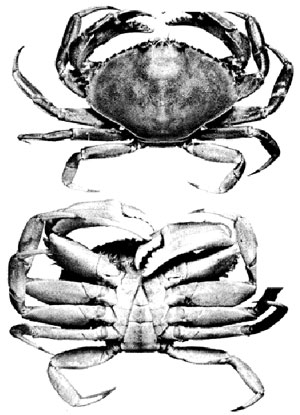 FIGURE 3. Slender crab, Metacarcinus gracilis. Top and bottom views of a 2½-inch male specimen.
FIGURE 3. Slender crab, Metacarcinus gracilis. Top and bottom views of a 2½-inch male specimen.
Distinguishing Characters: White-tipped pincers on the claws. The tops of the claws are sharp-edged, with two or three prominent teeth, but these edges are not sawtoothed as in the market crab. The last three joints of all the walking legs are hairless. Compare particularly the last three joints of the last pair of legs with those of the Dungeness crab (Figures 1 and 2), the only other crab of this group which has white-tipped pincers, and with which this crab may be confused. Since the slender crab seldom exceeds a width of 3 inches across the back, it can only be confused with the young of the Dungeness crab. The tip of the last segment of the tail flap is pointed in both male and female. For an example of this pointedness, see Figures 3 and 5 and compare with the roundness of this last segment in the Dungeness crab as shown in Figures 2A and 2B.
Color: Light olive brown. The coloring on the front sides of the legs may be a yellowish brown to a purple color in darker specimens. The underside is white or yellowish white.
Size: Attains a width of 3½ inches across the back.
Distribution: Alaska to Sebastian Vizcaino Bay, Baja California.
Romaleon antennarius
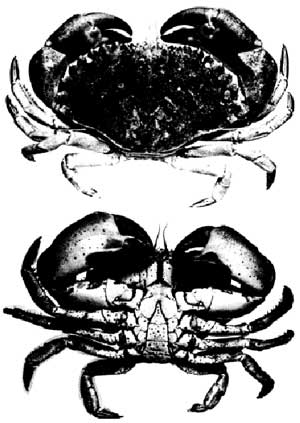 FIGURE 4. Brown rock crab, Romaleon antennarius. Top and bottom views of a male crab, 5 inches across the back.
FIGURE 4. Brown rock crab, Romaleon antennarius. Top and bottom views of a male crab, 5 inches across the back.
Distinguishing Characters: Black-tipped pincers on the claws. The hand of the claw is large and smooth. There are a number of small red spots on the underside of the crab (as shown in the photograph) and these are not found on any other crab herein described. In the female, the red spots on the tail flap are usually blocked out by a general red coloration, but the spots can be found on the legs and the underside of the carapace (the red crab may have red blotchings on the underside, but these should not be confused with the distinct spots found in the rock crab). The tip of the last segment of the tail flap is pointed in both male and female, as for all other crabs described except the Dungeness crab. The two antennae are longer in this species than in any of the others described.
Color: Medium to dark red-brown, usually mottled with a lighter grayish tinge. Underparts yellowish white, with some red, and the characteristic red spots are noted above.
Size: Attains a width of 7 inches across the back.
Distribution: British Columbia to Magdalena Bay, Baja California.
Note: Occasionally a small female specimen is encountered that is exceedingly hairy on the legs and underparts, and with the long antennae feather-like. This is an extreme variation of this species, and the red spots on the undersurface, together with the other characters as above, will serve to identify it.
Cancer productus
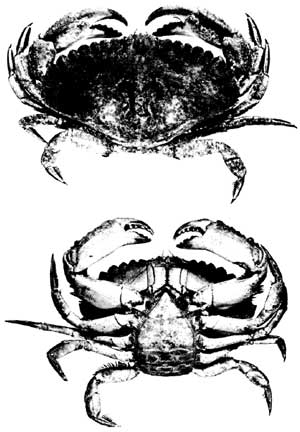 FIGURE 5. Red crab, Cancer productus. The upper photograph shows the top surface of a 6½-inch male. The lower photograph shows the under surface of a 5¾-inch female crab.
FIGURE 5. Red crab, Cancer productus. The upper photograph shows the top surface of a 6½-inch male. The lower photograph shows the under surface of a 5¾-inch female crab.
Distinguishing Characters: Black-tipped pincers on the claws. The hands of the claws are noticeably roughened, particularly above, but not distinctly sawtoothed as in the Dungeness crab. The five teeth between the eyes on the front edge of the carapace are of nearly equal size and project a little forward of the eyes. The tip of the last segment of the tail flap is pointed in both male and female, as for all other crabs described except the Dungeness crab.
Color: Dark red above, but some specimens are medium red. The underside is yellowish white with orange red blotchings. The tail flap in the female has a great deal of red, as does the tail flap of the female rock crab. The red blotchings on the underside of the red crab are not to be confused with the distinct red spots found on the underside of the rock crab.
Size: Attains a width of 8 inches across the back.
Distribution: Alaska to Magdalena Bay, Baja California.
Metacarcinus anthonyi
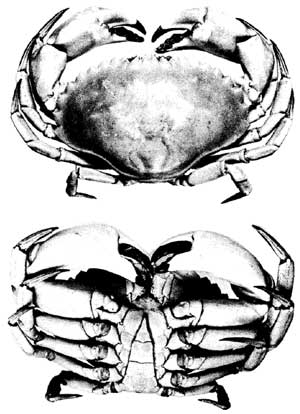 FIGURE 6. Yellow crab, Metacarcinus anthonyi. Top and bottom views of a male crab, 6 inches across the back.
FIGURE 6. Yellow crab, Metacarcinus anthonyi. Top and bottom views of a male crab, 6 inches across the back.
Distinguishing Characters: Black-tipped pincers on the claws. The hands of the claws are large and quite smooth, resembling the rock crab in this respect. In fact, all of the legs of the yellow crab are quite smooth. The last five joints of the walking legs lack hair except for very short bristles on the end joints. These bristles may become indistinguishable to the unaided eye, on the last pair of legs. The tip of the last segment of the tail flap is pointed in both male and female, as for all other crabs described except the Dungeness crab.
Color: Yellow-brown, with a purple wash anteriorly and on the legs in some specimens. Underparts plain yellow or yellowish white.
Size: Attains a width of 7 inches across the back.
Distribution: Humboldt Bay to Magdalena Bay, Baja California, but generally uncommon north of Point Conception.
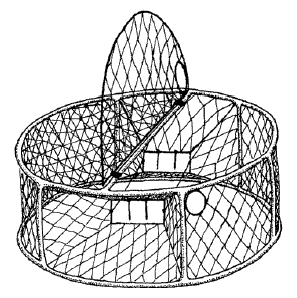 FIGURE 7. A crab trap of stainless steel wire woven about a welded iron frame. Note the circular openings to allow escape of undersized crabs
FIGURE 7. A crab trap of stainless steel wire woven about a welded iron frame. Note the circular openings to allow escape of undersized crabs
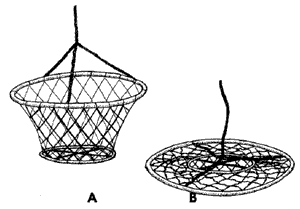 FIGURE 8. Crab hoop net. (A) the trap extended as it is while being hauled to the surface. (B) the trap as it is when on the bottom of the ocean.
FIGURE 8. Crab hoop net. (A) the trap extended as it is while being hauled to the surface. (B) the trap as it is when on the bottom of the ocean.
Some commercial crab fishermen prefer to build their own crab traps (pots), although several Pacific coast companies manufacture these traps. A circular pot (Figure 7) 42 inches in diameter, 14 inches deep, and weighing 90 pounds could be purchased in 1971 for about $32. Completely equipped with line, buoys, and bait container, each unit represented an investment, at that time, of about $42. The 1986 respective prices for a trap and one rigged for fishing are $60 and $80.
The crab ring or hoop net (Figure 8) is used by California sport crabbers and a few commercial fishermen. This unit consists of coarse mesh webbing attached to two iron hoops. When the trap is on the bottom, crabs are attracted to the center of the net by bait held in a small receptacle. Periodically, the net is hauled to the surface quickly thereby capturing any crabs in the net.
- Hipkins, Fred W. 1972. Dungeness crab pots. Fishery Facts-3, NMFS Extension pub.,:l-13.
- Jow, Tom. 1961. Crab trap escape opening studies. Pac-Mar Fish. Bull. (5):117-150.
- Phillips, J. B. 1939. The market crab of California and its close relatives. California Department of Fish and Wildlife, 25 (1) :18-29.
- Rathbun, Mary J. 1930. The cancroid crabs of America of the families Euryalidae, Portunidae, Atelecyclidae, Cancridae and Xanthidae. U.S. Nat. Mus. Bull., (152) :1-609.
- Schmitt, Waldo L. 1921. The marine decapod crustacea of California. Univ. Calif. Pub. Zool., 23:1-470.
- Waldron, Kenneth D. 1958. The fishery and biology of the Dungeness crab (Cancer magister Dana) in Oregon waters. Oregon Fish Comm., Contrib., (24) :1-43.
- Wild, Paul W. and Robert N. Tasto (eds.) 1983. Life history, environment, and mariculture studies of the Dungeness crab, Cancer magister, with emphasis on the central California fishery resource. California Department of Fish and Wildlife, Fish Bull., (172) :1-352.